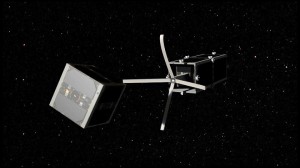
An artist’s impression of the CleanSpace One satellite approaching a defunct satellite (Credits: EPFL).
The Swiss Space Center at the Swiss Federal Institute for Technology in Lausanna, or EPFL, announced Wednesday that it is planning to launch a satellite to remove debris from low-Earth orbit. The 11-million USD satellite, named CleanSpace One, is intended to actively intercept and deorbit defunct satellites that contribute to the growing cloud of LEO debris as they disintegrate and collide with one another.
“It has become essential to be aware of the existence of [space] debris and the risks that are run by its proliferation,” said Claude Nicollier, astronaut and EPFL professor. Volker Gass, the director of the Swiss Space Center, said it hopes to “offer and sell a whole family of ready-made systems, designed as sustainably as possible, that are able to de-orbit several different kinds of satellites.”
EPFL has stated that the first CleanSpace One satellite would be launched within three to five years. The target mission would be to intercept two Swiss satellites, launched in 2009 and 2010.
There are several technical challenges the program will need to overcome before the satellite can be launched, the first of which is the requirement for the small satellite to perform precise adjustments of its trajectory to intercept its target. Swiss engineers are already investigating new technologies for ultra-compact space-capable motors. They are also trying to overcome the difficulties associated with grappling the satellites and deorbiting them such that they disintegrate in the upper atmosphere.
Presently, 21,000 human-made objects larger than ten centimeters in diameter orbiting the Earth are being actively tracked. It is further estimated that there are an additional 450,000 to 600,000 objects measuring between 1 and 10 centimeters diameter in Earth orbit, and many hundreds of millions measuring between 1 millimeter and 1 centimeter. A total of 16,000 objects larger than 10 centimeters have been catalogued by the US government, meaning that their respective origins have been possibly identified with a specific launch or release event. Of these, only 6 to 7 percent are operational satellites; at a minimum, more than 90% of all man-made objects in Earth orbit are uncontrolled and/or non-functional.
As these objects orbit at speeds of between 3 km/sec and 7.7 km/sec, a collision between one uncontrolled object of any size and another space object can have serious consequences and create still more debris, in a cycle that can eventually become self-sustaining (known as the Kessler syndrome). To mitigate the growing issue of space debris, many satellite operators follow international guidelines involving passivation of tanks (to prevent debris-creating explosions) and cooperation between countries to avoid collisions; however, no one has yet demonstrated how to economically deorbit defunct satellites and spent upper stages using dedicated “janitor” satellites.
The video below shows an explanation of the proposed CleanSpace One satellite and mission.

















































































































![A trajectory analysis that used a computational fluid dynamics approach to determine the likely position and velocity histories of the foam (Credits: NASA Ref [1] p61).](http://www.spacesafetymagazine.com/wp-content/uploads/2014/05/fluid-dynamics-trajectory-analysis-50x50.jpg)



Surely the real danger lies with the 100,000’s of smaller objects. Space-faring nations are responsible for creating the accumulation of the potential dangers of space debris and should jointly be investing in the solutions to removing it.
Although there are vastly more smaller objects that strike satellites more frequently, they’re almost impossible to remove by direct interception by another satellite. The reason for focusing on removing single, large satellites is to prevent catastrophic events like the the Chinese ASAT test or the Iridium/Cosmos collision, which created huge clouds of smaller debris.
For the little stuff, though, there are some really interesting concepts out there about using ground based (and even space-based) lasers to fry smaller bits of debris.